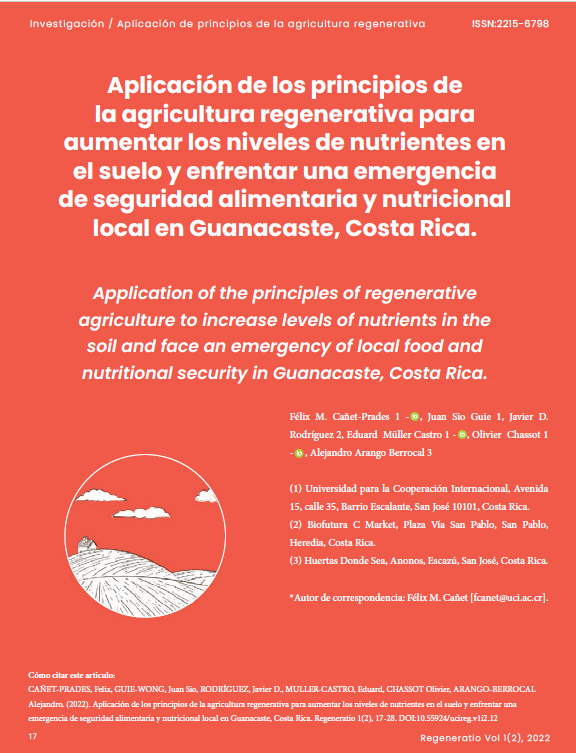Application of the principles of Regenerative Agriculture to increase levels of nutrients in the soil and face an emergency of local food and nutritional security in Guanacaste, Costa Rica
DOI:
https://doi.org/10.55924/ucireg.v1i2.12Keywords:
Agricultura regenerativa; policultivo, agricultura orgánica; compost; carbono; nitrógeno; potasio; fósforo; rendimientoAbstract
It is known that the implementation of regenerative agriculture improves soil health, increases biodiversity and returns carbon to it, while recycling nutrients, increasing yields, and improving the health and vitality of rural communities under the vision soil and healthy food, however there are few results in the application of these principles to strengthen food security in emergency situations. We report the results of an exploratory research focused on the establishment of an emerging food production system that integrated the application of regenerative agriculture principles and nature-based solutions, including the application of high doses of compost (100 t / ha) and a layer of dry grass (¨mulch¨ or vegetable cover) at a rate of 2-3 kg/m2, in combination with polyculture in a high bed of soil of different species and varieties of vegetables, the application of Integrated Pest Management and drip irrigation. The tests were carried out in Tempate, Santa Cruz, Guanacaste, Costa Rica, in a clay loam soil. It was shown that the carbon content in the soil increased from 1,65% (m/m) at the beginning of the experiments to 4,05%(m/m) and 3.70%(m/m) at 6 months and 12 months later, with an average of 2,26%(m/m); values higher than those found in the nearby gallery forest; this indicates the feasibility of increasing the sequestration capacity of C in regenerative orchards to levels equivalent to 58,9 t/ of C/ha/year, which was accompanied by an increase in the content of nitrogen in the soil from 0,14%(m/m) to 0,32% (m/m) and 0.37%(m/m) in those times, with values of the C/N ratio, similar to those of the nearby gallery forest, without significant changes in pH. The increases in the levels of assimilable phosphorus were particularly important, which rose from 1,67 mg/L of soil at the beginning of the experiments to values that fluctuated from 64,67 mg/L of soil (6 months) to 73,33 mg/L of soil (12 months), while potassium concentrations increased from 0,14 cmol(+)/L of soil to 1,21 cmol/L of soil (6 months) and 0,61 cmol(+)/L of soil (12 months), in correspondence with the lower values of the calcium/potassium, magnesium/potassium and (calcium + magnesium)/potassium ratios, which demonstrates the beginning of an important soil regeneration process associated with the cultivation of more than thirty species. In these trials, potential yields were estimated at 94 t/ha, with the consequent improvement in food and nutritional security, as well as the livelihoods of the beneficiaries.
References
Cañet-Prades, F.M., Sio-Guie J. , Rodríguez J. D., Müller-Castro, Olivier Chassot O. y Arango-Berrocal, A.(2022 Aplicación de los principios de la Agricultura Regenerativa para aumentar los niveles de nutrientes en el suelo y enfrentar una emergencia de seguridad alimentaria y nutricional local en Guanacaste, Costa Rica.

Additional Files
Published
How to Cite
Issue
Section
Categories
License
Copyright (c) 2022 Felix M Cañet Prades

This work is licensed under a Creative Commons Attribution-NonCommercial-ShareAlike 4.0 International License.
Contributions to the journal are made under the terms of the Creative Commons Attribution-NonCommercial-NoDerivatives 4.0 International License (CC BY-NC-ND 4.0).
The use of this type of license grants a user permission to share — copy and redistribute the material in any medium or format, as long as:
- Proper attribution or recognition is given to the author(s) of the licensed material and any other person designated for attribution or recognition, in any reasonable manner requested by the Licensor.
- A link to the license is provided, and it is indicated if changes have been made. This can be done in any reasonable manner, but not in a way that suggests that you or your use are endorsed by the Licensor.
- The material is not used for commercial purposes.
- The original content of the material is not modified. If remixing, transforming, or creating from the material, the modified material cannot be distributed.






